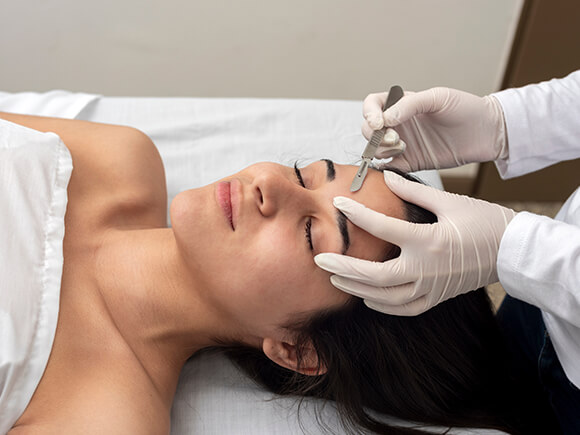Dermaplaning Facials: Revealing Radiant Skin Through Precision Exfoliation

Understanding Dermaplaning
The Benefits of Dermaplaning
Enhanced Skin Radiance: The most immediate and noticeable benefit of dermaplaning is the enhanced radiance it imparts to the skin. With the removal of the dull, dead skin cells and fine facial hair, your complexion appears brighter and healthier.
Reduction of Skin Imperfections: Dermaplaning can effectively diminish the appearance of skin imperfections such as acne scars, fine lines, and uneven texture. The treatment promotes a more even skin tone and a smoother surface.
Facilitates Product Absorption: After dermaplaning, your skin is primed to absorb skincare products more efficiently. Serums, moisturizers, and other treatments penetrate deeper, maximizing their effectiveness.
Safe and Minimally Invasive: Unlike more aggressive procedures, dermaplaning is non-invasive and has a minimal risk of side effects. It is suitable for various skin types and tones.
Painless and Quick: The procedure is virtually painless and typically takes 30-45 minutes to complete. There is no downtime, making it a convenient choice for those with busy schedules.
The Ageless Elixir of Dermaplaning
While dermaplaning can make your skin appear more youthful and radiant, it’s essential to clarify that it doesn’t halt the aging process. Instead, it offers a temporary but transformative solution to some of the visible signs of aging, such as fine lines and a lackluster complexion.
The shedding of dead skin cells and the removal of fine facial hair can create the illusion of youthful, smooth skin. It’s important to manage expectations and recognize that the results are not permanent. Regular dermaplaning sessions are required to maintain the desired effects.
Dermaplaning for Hair Removal
Apart from its benefits for the skin, dermaplaning is often sought for facial hair removal. The fine, vellus hair on the face, often referred to as “peach fuzz,” can be bothersome to some individuals. Dermaplaning provides a temporary solution to this concern, as the hair grows back over time. This aspect of the procedure offers a smoother canvas for makeup application and can be particularly appealing to those who prefer a flawless makeup finish.
The Dermaplaning Process
Dermaplaning is a precise and meticulous procedure that should only be performed by trained professionals. Here is an overview of the steps involved:
Cleansing: The treatment area is thoroughly cleaned to remove any makeup, dirt, or oil.
Preparation: The skin is prepared with a specialized solution to ensure a smooth glide of the dermaplaning tool.
Dermaplaning: Using a sterile scalpel or dermaplaning tool, the provider gently and skillfully scrapes the skin’s surface, removing dead skin cells and fine hair.
Hydration: After dermaplaning, a hydrating and soothing mask or serum may be applied to calm the skin.
Sun Protection: Applying sunscreen is crucial after the procedure to protect the newly exposed skin from UV damage.
Who Should Consider Dermaplaning?
Dermaplaning is suitable for a wide range of individuals, including those with various skin types and tones. It can be particularly beneficial for those with:
- Dull or lackluster skin
- Mild acne scars
- Fine lines and wrinkles
- Uneven skin texture
- Excessive facial hair
- An aversion to chemical exfoliation methods
The Dermaplaning Experience: What to Expect
When considering dermaplaning, it’s helpful to understand the treatment process and what to expect during and after your session:
Minimal Discomfort: The procedure is generally well-tolerated and causes minimal discomfort. Most individuals report a gentle scraping sensation.
No Downtime: There is no downtime associated with dermaplaning. You can resume your daily activities immediately after the treatment.
Immediate Results: You will notice an immediate improvement in the texture and radiance of your skin post-treatment.
Maintenance: To maintain the benefits of dermaplaning, regular sessions are recommended, typically every 4-6 weeks.
Conclusion
Dermaplaning is a remarkable cosmetic procedure that offers a quick and effective solution for enhancing your skin’s radiance and texture. With its ability to reduce the appearance of acne scars, fine lines, and uneven skin tone, it provides a temporary but transformative effect. Whether you seek a smoother complexion or a flawless makeup application, dermaplaning can be a valuable addition to your skincare routine. Consult with a trained professional to explore the benefits of this procedure, and embark on a journey towards radiant, revitalized skin.
